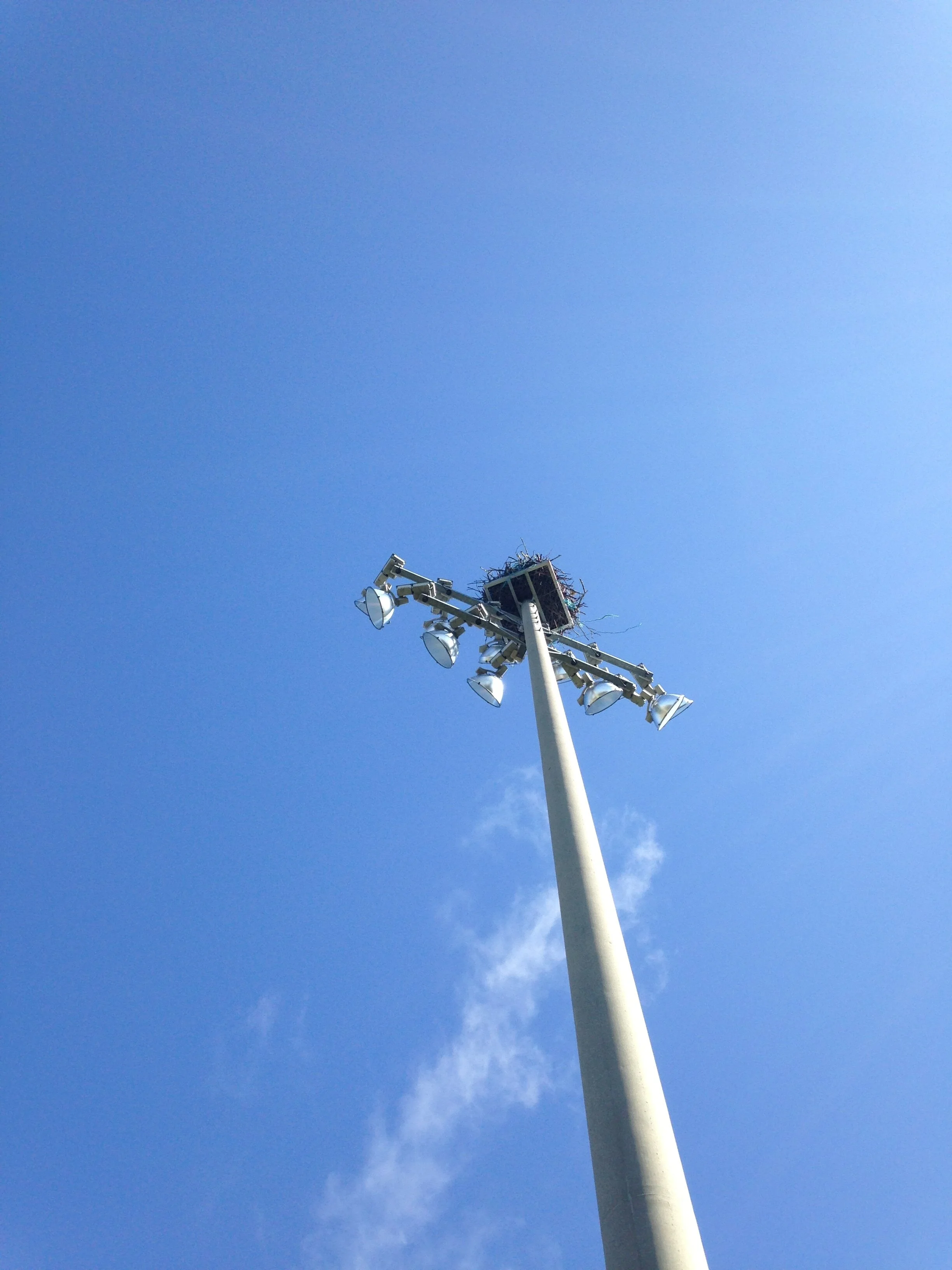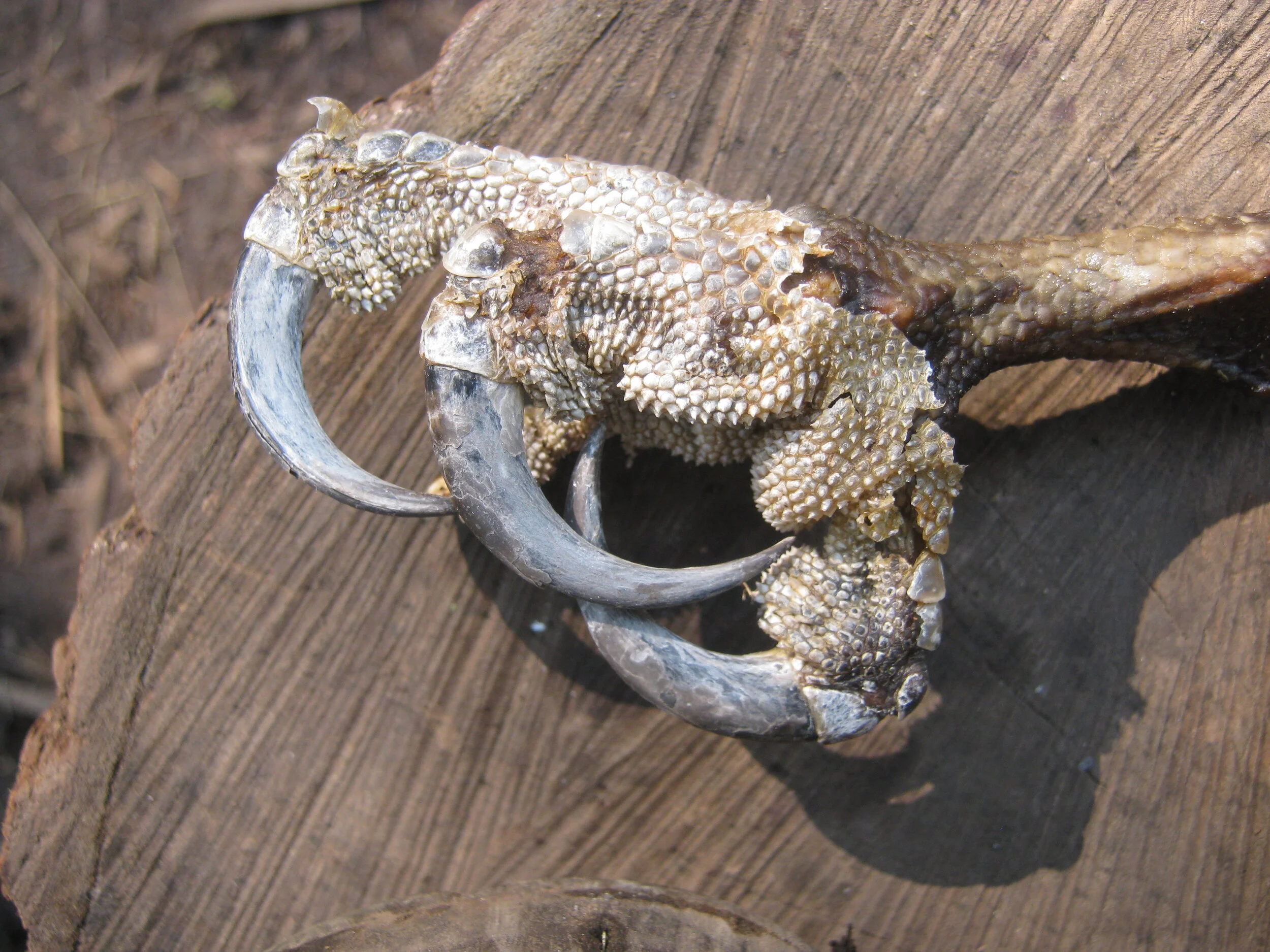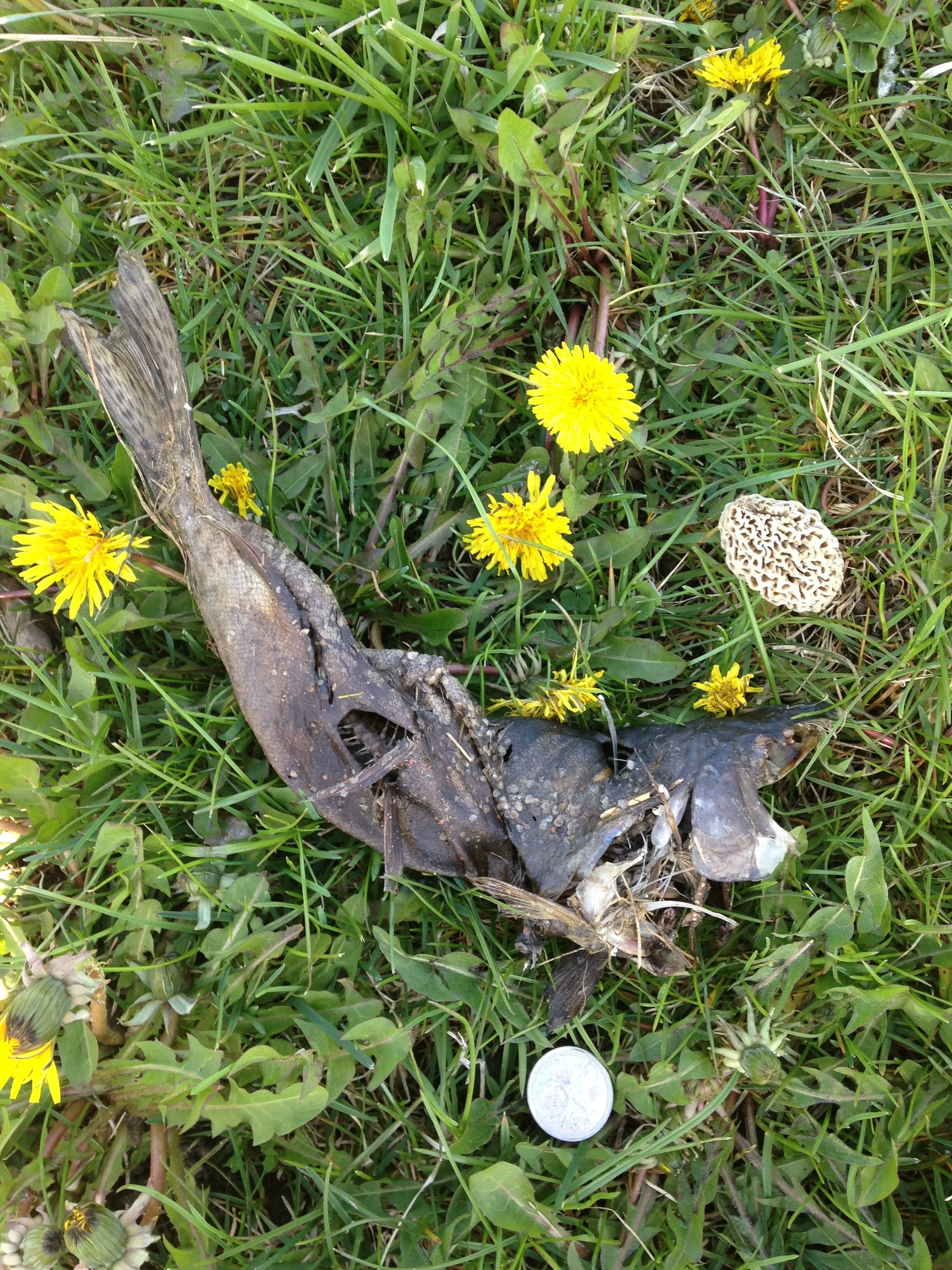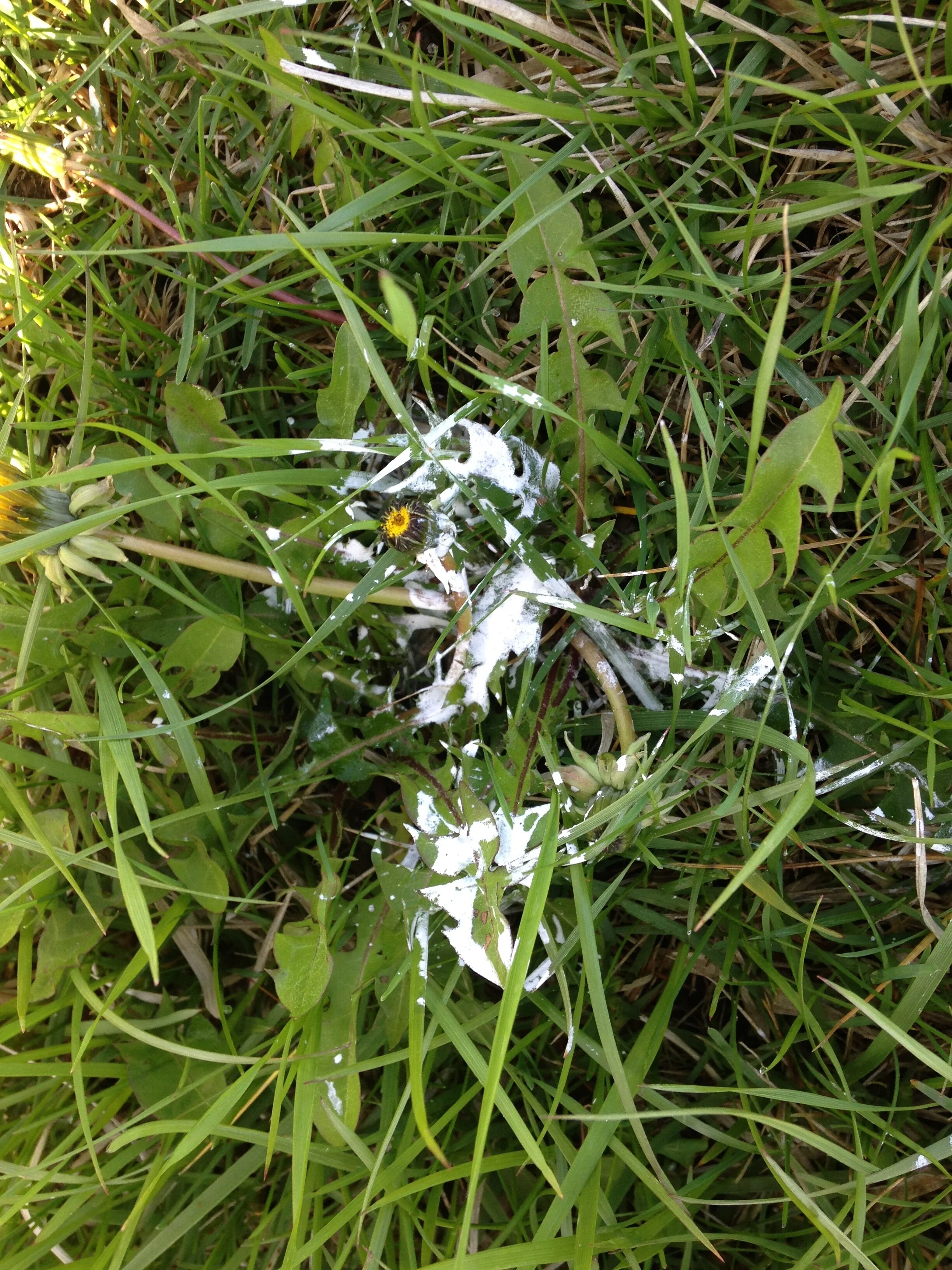Osprey and headless fish at Bishop Mac
Osprey nest, atop floodlights at the baseball diamond behind Bishop Mac in Guelph, Ont. May 10, 2021.
I went out to Bishop Mac with my pal Tamara to practice trailing Deer (Odocoileus virginianus) and Coyotes (Canis latrans) in hopes that I could learn more from Tamara how to see the signs when they aren’t an obvious clear track in perfect substrate. When we got there we watched an adult Osprey (Pandeon haliaetus) fly in with a Goldfish (Carassius auratus) and land atop a nest which had been built on a small flat platform mounted above the floodlights which shine down onto the baseball diamond. I had seen this Osprey family in previous years, and it was nice to see them back from their winter down South. We watched as the adult leaned over the brim of the nest and two small Osprey heads emerged. Almost as soon as the Osprey had arrived they took off again with the Goldfish still in their talons. This was strange to us. Why would the adult Osprey go catch a fish, then return to the nest of hungry little Osprey babies only to show the Goldfish and then to fly off again with it? Was it a lure to draw potential fledglings from the nest? Was the fish too large to feed the young birds? Was the Goldfish unintended for the young birds, but the elder Osprey just stopped by to check on them while attending to their own meal? Tamara and I had questions, but no way to answer them. I thought to myself that I would research the questions when I got home and get back to looking for any signs of Deer or Coyotes in the loose soil behind the baseball diamond.
Talon from a deceased Osprey found 08.10.2018
Close up of an Osprey talons rasp like under toe pads.
I have often thought that the Osprey talons were epic. They have huge curving semi-zygodactyl claws designed for catching, holding, and restraining prey. Ok.. wait back up.. what is semi-zygodactyl mean?
Osprey’s have the ability to rotate their toe 4 to meet toe 1 (the hallux) down from where it is often grouped with toes 2 and 3. The first position, which looks like a conventional bird foot with one toe pointing backwards (toe 1) and three toes pointing forwards (toes 2, 3, and 4) is called anisodactyl, and is commonly found on a lot of perching songbirds and some other birds of prey. But then Ospreys can rotate that toe 4 from the group in the front down towards toe 1 affording them greater grasping capabilities (big thanks to E.D. for pointing this out for me).
As the Ospreys toes close and the claws dig in to the flesh of their prey there is little room for a fish to wriggle free. But as an extra safeguard against losing their lunch Osprey talons come lined with small conical spikes which act like cleats on the bottom of a baseball or soccer shoe. These spikes help retain the grasp of struggling, and potentially slimy prey. Useful, especially since Ospreys have been seen carrying fish while migrating, “packing a lunch” as John Eastman puts it in his book Birds of Lake, Pond and Marsh. Another cool thing about the Osprey is that they most often carry their fish prey head first. Some researchers think this is about keeping everything aerodynamic but no one really knows why they do this. Aerodynamics makes sense to me, and I also think it would be a good idea to keep an eye on the bitey parts of whatever animal you might be carrying.
Back to the ball field, while we were looking down at the soil, one of the landscapers who was cleaning up the area of the baseball diamond came over and asked if we were looking for anything? He later explained that the way we were looking at the ground looked like we’d lost keys or something. We replied that no, we were just looking for animal tracks. At that, he began to tell us about all the Coyotes he sees in the area, and the Deer who hang out just on the ridge behind the ball field, and motioned for us to take note of the Osprey nest, where, since he works maintaining these baseball diamonds and is in the park often, he has seen many dead headless fish at the base of the pole which the nest sits on top of. With his remark about the dead headless fish I got curious. I think Tamara did as well. I think we simultaneously figured out what we had seen going on with the adult Osprey bringing the fish and then flying off again with the fish. Perhaps when the Osprey was flying away that fish might have been a little bit lighter. Perhaps when the Osprey was flying away that fish, it might have been missing the head, but we just couldn’t see it from down below! I know Great Horned Owls (Bubo virginianus) often just eat the head of the birds they take, so why couldn’t an Osprey?
When the landscaper man left I made my way over towards the pole where the Osprey nest was to see if I could find any signs of anything left behind by the Osprey, and lo and behold…
Unidentified headless fish, along with Morel mushroom, Dandelions, and canadian quarter (23.88mm D) for scale.
I found a fish! Without a head! Looks like the fish had had their head ripped apart by one of the adults, and then was possibly fed to the young Ospreys? I did find a video of just that. In the video an adult Osprey can be seen ripping apart the head of a fish and feeding these bits to nestlings. While the situation we observed with the adult bringing the fish to the nest and then leaving happened a bit quicker than in the video, it could be the same process. I can’t i.d. the fish that we found below the nest for certain, but I have some leanings towards Rainbow Trout (Oncorhynchus mykiss) because of the spotted caudal fin, and because Rainbows would be in the area (maybe even from a stocked pond nearby).
According to Arthur C. Bent, in his book Life Histories of North American Birds of Prey, the males hunt most while the females hang out in the nest with the young. The male will then bring the fish to the nest, and then the females will often take the fish and begin feeding the fish to the young. There is a quote in the book from M.P. Skinner, Yellowstone’s first hired field naturalist, who did the first western-scientific studies on Osprey in 1917, about how he observed a male returning to a nest, but was perched in a nearby tree. The male Osprey had torn the head off of a fish and then brought it to the nest. The book also notes that the nestlings can feed themselves (though still not hunt for themselves), at about five or six weeks old, meaning that the birds we saw today likely weren’t that old yet.
In his book Ospreys : The Revival of a Global Raptor, Alan F. Poole writes about how males will perch with a fresh caught fish, and then start digging into the front end first, consuming the head and up to half of the fish before bringing the rest to the nest for the female and the nestlings to finish off.
I also found a great discussion online about why male Ospreys eat the head first before feeding the fish to their young, and while this may often be the case, it isn’t the case all the time, as see in the video, which appears as if the female is ripping up the face when feeding the young in the nest.
I still have some lingering questions. Why did the Osprey fly in and then away? It was too quick to be eating the head of the Goldfish. Could it have been the male flying in, and then when recognizing that the fish was not dead yet, flew off to kill it before bringing it back? A live fish can be a dangerous thing in a nest with unfledged birds, flipping around all over the place, could knock a nestling out of the nest! Another question is where did the Rainbow come from? While the closest ponds aren’t stocked I know there is a lot of private land nearby, and some of that land has small ponds. Could folks be stocking their ponds for casual fishing? Is that even a thing? Also, why was so much of the fish we found left untouched? It seems only the head and was dug into by the Osprey but the rest of the fish was unshredded. It looked fed upon, and there is the gaping hole in the belly, but from what I have seen this isn’t the work of an Osprey; maybe a rodent or insects? Ever more to know.
Checking out the ground around the base of Osprey nests might become a new sport for me this summer. I’ll continue to look in case I come across anything cool, unusual, or even the common and expected.
Osprey whitewash across Dandelions





